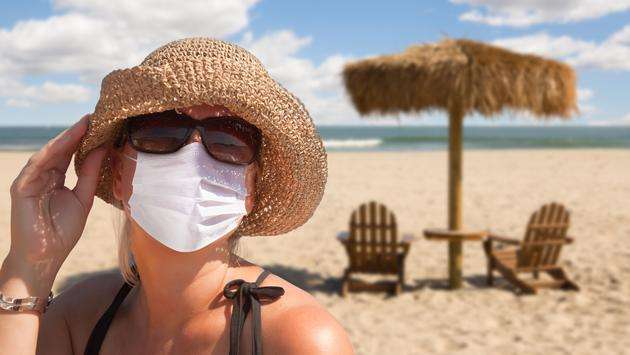The CDC may be warning Americans not to travel to Mexico , but COVID-fatigue is real, and many are still seeking to get away and are not heeding the advice.

With airlines adding new flights, hotels reopening in time for the holidays and deals aplenty, Mexico presents an enticing opportunity for much-needed R&R in paradise.
It is also one of few destinations open to Americans that currently does not require a negative COVID-19 test for entry.
There are in fact no restrictions on Americans traveling to Mexico. However, the current State Department Mexico Travel Advisory does recommend Americans reconsider visiting the country due to COVID-19. Before leaving, travelers should make sure to read the State Department’s current COVID-19 travel advice , ensuring that they can travel to and re-enter the U.S. without restrictions at the time they are traveling.
Many travelers and travel advisors who have already visited said that they feel safer at Mexico’s secluded resorts than they do at big box stores in the States.
"I felt safer there than I would at a Target or market in Los Angeles," Ashley Lewis, who has traveled to Mexico several times since March told ABC News. "The resorts were secluded, they weren't selling the hotels to 100 percent capacity, and everyone was wearing masks and abiding by the rules. So much in those areas are dependent on tourism, and you could tell they were working incredibly hard to make the guests feel safe."
So what should travelers do if they are traveling to Mexico and want to stay safe at the same time?
The World Travel & Tourism Council (WTTC) has instituted a global travel safety program called “Safe Travels,” and many countries, cities, destinations and travel companies have applied to receive this certification, which requires rigorous cleaning and hygiene protocols are followed before qualifying for the designation.
Most of Mexico’s most popular tourist destinations have received WTTC Safe Travels certification , including Los Cabos, Puerto Vallarta, Riviera Nayarit, Cancun, Playa del Carmen, Riviera Maya and the Yucatan.
The Mexican government has also instituted its own health and safety certification, Clean Point Quality Seal V2020, designed for smaller or medium-sized businesses in the country.
When arriving at the airport, travelers should expect to see enhanced screenings and hygiene measures. Cancun’s airport has installed thermal scanners and will stop people who register a temperature.
Travelers will also see signs encouraging social distancing, hand sanitizing stations and lower capacities.
When visiting anywhere, travelers should also follow CDC guidelines and advice to ensure safety.
The CDC's Dr. Kristina Angelo advises travelers to make sure that COVID-19 isn’t spreading where they are going and to follow basic safety guidelines.
“Wear a mask, keep your nose and mouth covered in a public setting, avoid close contact and stay six feet apart, which I measure with two arm lengths,” said Angelo. “It’s important to wash your hands, use hand sanitizer, stay away from people who could be ill, and don’t touch your eyes, nose or mouth.”
Since most travelers will be staying at a hotel or resort, Angelo also advises travelers to be as contactless as possible.
“Some hotels offer mobile room keys, contactless payment etcetera,” she said. “Many hotels have removed a lot of the frequently touched surfaces in the event your hotel has not, make sure you aren’t using them or are sanitizing them.”
Travelers should also check if the hotel or property where they are staying has updated its own health and safety protocols .
Many Mexican resorts have instituted new measures that are designed to keep workers and guests safe during their stay, including reduced occupancy, social distancing, new dining standards and more that are easily found on a hotel’s website.
Most resorts will check your temperature upon arrival, and guests may be asked to fill out a health questionnaire. Luggage and shoes may be sanitized, and hand sanitizer will likely be provided.
Expect that all guests and staff will be wearing a mask. Many resorts provide guests with personal PPE safety kits that include masks, hand sanitizer and disinfecting wipes.
“Due to the low occupancy in resorts, once a person checks out, housekeeping sanitizes the entire room and keeps it vacant for a minimum of 24 hours before it is assigned to another guest,” reported Nick Amin of Alpha Travel .
Pool areas and dining areas will also look different. Capacity levels may be monitored, and seating areas have been rearranged to ensure people maintain distances of at least six feet from one another.
While travelers may be encouraged to stay home, the overall consensus of people who have visited the region’s resorts was that it is possible to travel to Mexico and be safe.
"After my stay, I felt extremely comfortable sending my clients to Mexico,” said Royal Destinations travel advisor Jovi Welch, who visited back in August. “Since then I’ve booked over ten last-minute vacations, and every one of them said how much of a great and safe experience that they had. I can’t speak for all destinations, but what I can say is: If you are ready to take a family vacation, bae-cation, a girls trip, guys getaway, or even travel solo, Mexico is the place to be.”
When returning to the U.S. from abroad, including Mexico, travelers should check their state and local guidelines for reentry and quarantine. Due to a surge in COVID cases around the country, many states and municipalities have added new restrictions on travel in order to prevent the spread of the virus. The situation remains in flux, and those who do leave should be prepared in case their state or city introduces these measures.
Leave a Comment